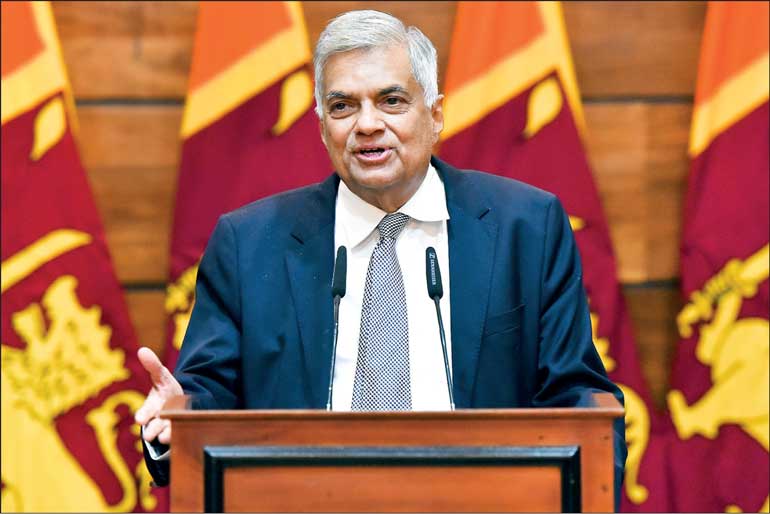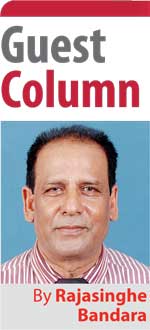Monday Apr 07, 2025
Monday Apr 07, 2025
Wednesday, 24 August 2022 00:00 - - {{hitsCtrl.values.hits}}

President Ranil Wickremesinghe
Ranil Wickremesinghe became the Executive President as a result of the victorious struggle against the corrupt Rajapaksa regime which led the country to collapse and bankruptcy. The irony is Ranil Wickremesinghe had been portrayed as a failed political leader during the tenure of former President Mahinda Rajapaksa, but the Rajapaksas, finally, handpicked him as ‘the Saviour of the Nation’.
corrupt Rajapaksa regime which led the country to collapse and bankruptcy. The irony is Ranil Wickremesinghe had been portrayed as a failed political leader during the tenure of former President Mahinda Rajapaksa, but the Rajapaksas, finally, handpicked him as ‘the Saviour of the Nation’.
Wickremesinghe himself accused Mahinda Rajapaksa of entering into a secret deal with the Tamil Tigers to win the presidential elections in 2005. The LTTE ordered the Tamil voters in the North and East to boycott the election in favour of Mahinda Rajapaksa. Ranil was defeated with a slim margin. The United National Party (UNP) said Rajapaksa offered Rs. 1,500 million to LTTE before and after the November 2005 presidential elections. During the last general election, Podujana Peramuna with their powerful election campaign against UNP and Ranil Wickremesinghe managed to wipe out UNP by exposing the Central Bank bond scam. Therefore Ranil Wickremesinghe must be grateful to the protesters and the leaders of the people’s struggle/Aragalaya for becoming the president. If Wickremesinghe wants to extend the hand of friendship with them he should stop the crackdown on the protesters.
President Wickremesinghe made an impressive speech at the inauguration of the Parliament on the 3rd of this month. He raised hopes of the people promising to bring changes that the participants of the Aragalaya expected. People do not just believe the words; they judge the rulers through their actions. His focus should be addressing the harsh economic conditions with the support of the Opposition. Protesters should be an integral part of the rebuilding process.
I have been monitoring the situation in Sri Lanka from London and therefore I have in-depth knowledge about the people’s struggle from the beginning. Corrupt MPs in the Government and so-called independent groups including Wimal Weerawansa labelled the popular uprising, Aragalaya, as an evil political movement. MP Sanath Nisantha, who was among the violent attackers on the peaceful protesters on 9 May, described in a media conference, the uprising was JVP-led terrorism and proposed to crush them like former Prime Minister Sirima Bandaranaike did in 1971 and, President J.R. Jayewardene and President Ranasinghe Premadasa did in 1988 and 1989. It has been reported between 1988-1989 more than 60,000 people were killed as JVP suspects. Is this the solution they expect for the crisis?
Is that the truth about the popular uprising against Gotabaya Rajapaksa and his family regime? Regardless of age, ethnicity, education, religious backgrounds, people from all sort of backgrounds including university professors to poor villagers, doctors to healthcare workers, little children to elderly people, came to the streets from every corner of the island demanding the Rajapaksas to ‘Go Home’ because the worst economic crisis in our history, created by the Rajapaksa regime, hit everyone in the country.
People had been protesting against the Gotabaya Rajapaksa regime on various critical issues such as rising cost of living, human-elephant conflict, fertilisers for farming, billions of tax frauds, etc. But his Government did not want to hear the outcry of the people. Even during the peak of the COVID-19 pandemic, risking their lives, people came to streets demanding their rights. Finally the anger exploded.
Lanka eNews writer Keerthi Ratnayake, in his recent interview with Hiru news presenter Chamuditha Samarawickrama, was telling the audience that former president Chandrika Bandaranaike was the mastermind of the Galle Face protests to defame Aragalaya. On the other hand he accepted he was an informant to the President Gotabaya Rajapaksa. It is sad some journalists appear in public as saviours but behind the scenes they have their selfish agendas endangering the innocent people of the country like Namal Kumara who misled the people to cover up the Easter Sunday conspiracy.
President Wickremesinghe is well-aware of the entrenched attitude of the current members of the parliament (MPs). The protesters chanted slogans condemning all 225 MPs, as they know the majority of the MPs are corrupt, some have criminal backgrounds and they always consider their own advantages. It is similar to the recent remarks of former Pakistani prime minister Imran Khan while he was being interviewed by Sky news channel. He said two-thirds of MPs in the parliament were criminals, 60% of cabinet ministers on bail, and the Prime Minister was about to be sentenced. But they are safe because they backed the overthrow my government as expected by America.
The best example I can give about the majority of the MPs is, the voting for the 20th Amendment giving dictatorship powers to former president Gotabaya Rajapaksa. No president in the world, including American and French Presidents, had such enormous executive powers. Those MPs who voted for the 20th Amendment knew the four decades of bloodshed our people had witnessed due to the dictatorship rules. They are also responsible for the current situation.
Wickremesinghe is a knowledgeable person, when he speaks and responds to journalists and foreign interviewers; he supports his argument with international examples. But unfortunately he does not demonstrate his knowledge about how people react when they are provoked. Therefore I give some examples from recent protests from the UK, France, and the USA, mainly for those interpret and label the uprising as terrorism.
In 2010, when the Tory government led by David Cameron increased the university tuition fee from £ 3,000 to £ 9,000, thousands of protesters gathered in London and protests turned violent. Hundreds of student protesters clashed with police during the rally. Crowds of student protesters broke into 30 Millbank, where the Conservative Party’s headquarters are based, smashing the windows and wrecking the lobby as the peaceful demo turned ugly.
They got onto the roof, lit fires and threw missiles at police. The protesters, enraged by a Parliament vote to triple university tuition rate caps, attacked the car carrying Prince Charles and Camilla, Duchess of Cornwall, Thursday night on 9 December 2010. The demonstrators broke a window and tossed paint on the car, however neither royal family member was injured in the attack.
On 27 October 2005, two French youths of Malian and Tunisian descent were electrocuted when they entered a power station to evade police arrest in the Parisian suburb of Clichy-sous-Bois. Their deaths sparked nearly three weeks of rioting in 274 towns throughout the Paris region, France, and beyond. The rioters, mostly unemployed teenagers from destitute suburban housing projects, caused over € 200 million in damage as they torched nearly 9,000 cars and dozens of buildings, day-care centres, and schools. The French police arrested close to 2,900 rioters; 126 police and firefighters were injured, and there was one fatality – a bystander who died after being struck by a hooded youth.
On 25 May 2020, George Floyd, a 46-year-old black man died after a brutal police arrest in the US city of Minneapolis. Floyd had been arrested on suspicion of using a counterfeit $ 20 bill. After the arrest the white police officer Derek Chauvin knelt on Floyd’s neck for over nine minutes while Floyd was handcuffed and lying face-down in a street. As a result the black man died.
The George Floyd protest movement began hours after his murder as bystander video was being circulated on social media and word of mouth began to spread. Protests first emerged at the East 38th and Chicago Avenue street intersection in Minneapolis, the location of Floyd’s arrest and murder, and other locations in the Minneapolis–Saint Paul metropolitan area of Minnesota. Protests quickly spread nationwide and to over 2,000 cities and towns in over 60 countries in support of the Black Lives Matter (BLM) movement.
Polls in the summer of 2020 estimated that between 15 million and 26 million people had participated at some point in the demonstrations in the United States, making the protests the largest in US history. The rioting, looting, and arson that was seen in some 20 states in the days and weeks following the 25 May police killing of George Floyd in Minneapolis could cost the insurance industry up to $ 2 billion in claims, it has been reported.
In April, at Rambukkana, police shot dead one person, a father of two, 40-year-old man and injured about 27, some critically, in an attack on a protest of thousands against the latest fuel price increase. Chaminda Lakshman was shot dead by police while he was waiting to get fuel. On 9 May peaceful protests turned violent when former Prime Minister Mahinda Rajapaksa’s supporters brutally attacked peaceful protesters outside Temple Trees and at Galle Face Green. The attack triggered countrywide violence.
Can anyone still say the reactions of the people are terrorist activities? Who must be made responsible for the violence and destruction? It is a question for President Wickremesinghe and the MPs who label protesters as terrorists. Sri Lanka is the only country label popular uprising as terrorism.
(The writer is Operations Director – MTJ Global UK, Educator and has previously worked as a lecturer of Information and Communication Technology. He is also a researcher and writer on Sri Lanka’s nature, wildlife, and the environment, and for the common good. He lives and works in the UK.)
Discover Kapruka, the leading online shopping platform in Sri Lanka, where you can conveniently send Gifts and Flowers to your loved ones for any event including Valentine ’s Day. Explore a wide range of popular Shopping Categories on Kapruka, including Toys, Groceries, Electronics, Birthday Cakes, Fruits, Chocolates, Flower Bouquets, Clothing, Watches, Lingerie, Gift Sets and Jewellery. Also if you’re interested in selling with Kapruka, Partner Central by Kapruka is the best solution to start with. Moreover, through Kapruka Global Shop, you can also enjoy the convenience of purchasing products from renowned platforms like Amazon and eBay and have them delivered to Sri Lanka.
Discover Kapruka, the leading online shopping platform in Sri Lanka, where you can conveniently send Gifts and Flowers to your loved ones for any event including Valentine ’s Day. Explore a wide range of popular Shopping Categories on Kapruka, including Toys, Groceries, Electronics, Birthday Cakes, Fruits, Chocolates, Flower Bouquets, Clothing, Watches, Lingerie, Gift Sets and Jewellery. Also if you’re interested in selling with Kapruka, Partner Central by Kapruka is the best solution to start with. Moreover, through Kapruka Global Shop, you can also enjoy the convenience of purchasing products from renowned platforms like Amazon and eBay and have them delivered to Sri Lanka.